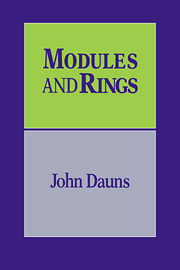Book contents
- Frontmatter
- Contents
- PREFACE
- NOTE TO THE READER
- CHAPTER 1 MODULES
- CHAPTER 2 FREE MODULES
- CHAPTER 3 INJECTIVE MODULES
- CHAPTER 4 TENSOR PRODUCTS
- CHAPTER 5 CERTAIN IMPORTANT ALGEBRAS
- CHAPTER 6 SIMPLE MODULES AND PRIMITIVE RINGS
- CHAPTER 7 THE JACOBSON RADICAL
- CHAPTER 8 SUBDIRECT PRODUCT DECOMPOSITIONS
- CHAPTER 9 PRIMES AND SEMIPRIMES
- CHAPTER 10 PROJECTIVE MODULES AND MORE ON WEDDERBURN THEOREMS
- CHAPTER 11 DIRECT SUM DECOMPOSITIONS
- CHAPTER 12 SIMPLE ALGEBRAS
- CHAPTER 13 HEREDITARY RINGS, FREE AND PROJECTIVE MODULES
- CHAPTER 14 MODULE CONSTRUCTIONS
- CHAPTER 15 CATEGORIES AND FUNCTORS
- CHAPTER 16 MODULE CATEGORIES
- CHAPTER 17 FLAT MODULES
- CHAPTER 18 PURITY
- APPENDIX A BASICS
- APPENDIX B CERTAIN IMPORTANT ALGEBRAS
- LIST OF SYMBOLS AND NOTATION
- BIBLIOGRAPHY
- SUBJECT INDEX
- AUTHOR INDEX
CHAPTER 7 - THE JACOBSON RADICAL
Published online by Cambridge University Press: 20 October 2009
- Frontmatter
- Contents
- PREFACE
- NOTE TO THE READER
- CHAPTER 1 MODULES
- CHAPTER 2 FREE MODULES
- CHAPTER 3 INJECTIVE MODULES
- CHAPTER 4 TENSOR PRODUCTS
- CHAPTER 5 CERTAIN IMPORTANT ALGEBRAS
- CHAPTER 6 SIMPLE MODULES AND PRIMITIVE RINGS
- CHAPTER 7 THE JACOBSON RADICAL
- CHAPTER 8 SUBDIRECT PRODUCT DECOMPOSITIONS
- CHAPTER 9 PRIMES AND SEMIPRIMES
- CHAPTER 10 PROJECTIVE MODULES AND MORE ON WEDDERBURN THEOREMS
- CHAPTER 11 DIRECT SUM DECOMPOSITIONS
- CHAPTER 12 SIMPLE ALGEBRAS
- CHAPTER 13 HEREDITARY RINGS, FREE AND PROJECTIVE MODULES
- CHAPTER 14 MODULE CONSTRUCTIONS
- CHAPTER 15 CATEGORIES AND FUNCTORS
- CHAPTER 16 MODULE CATEGORIES
- CHAPTER 17 FLAT MODULES
- CHAPTER 18 PURITY
- APPENDIX A BASICS
- APPENDIX B CERTAIN IMPORTANT ALGEBRAS
- LIST OF SYMBOLS AND NOTATION
- BIBLIOGRAPHY
- SUBJECT INDEX
- AUTHOR INDEX
Summary
Introduction
The kind of theory developed here follows a pattern which is discernible in other such related theories. One starts with some given class ∑ of modules, and then defines the radical corresponding to ∑ to be the intersection of the annihilator ideals of all the modules in ∑.
Set theory is applicable mostly to sets, but possibly not always to the larger entities called classes, like the class of all (one sided) simple modules ∑ used in this chapter. However, module isomorphism is an equivalence relation ∼ on ∑. The equivalence classes modulo this relation do form a set, the set ∑/ ∼ of all isomorphism classes of simple modules. By the axiom of choice we can select one representative out of each equivalence class giving us a set ∑* of simple modules. Every simple module is isomorphic to exactly one element of ∑*. In all of what follows all the results could be rephrased in terms of ∑*. However, for the sake of simplicity and directness, we will use ∑ instead.
An ideal (such as a radical) could be described or characterized in the following three different ways: (i) by specifying what types of (one sided) ideals or what types of elements it necessarily must always contain; or (ii) as an intersection of certain types of (one sided) ideals, (iii) Necessary and sufficient conditions could be found in order for an arbitrary element of the ring to belong to the radical in question.
- Type
- Chapter
- Information
- Modules and Rings , pp. 111 - 139Publisher: Cambridge University PressPrint publication year: 1994

